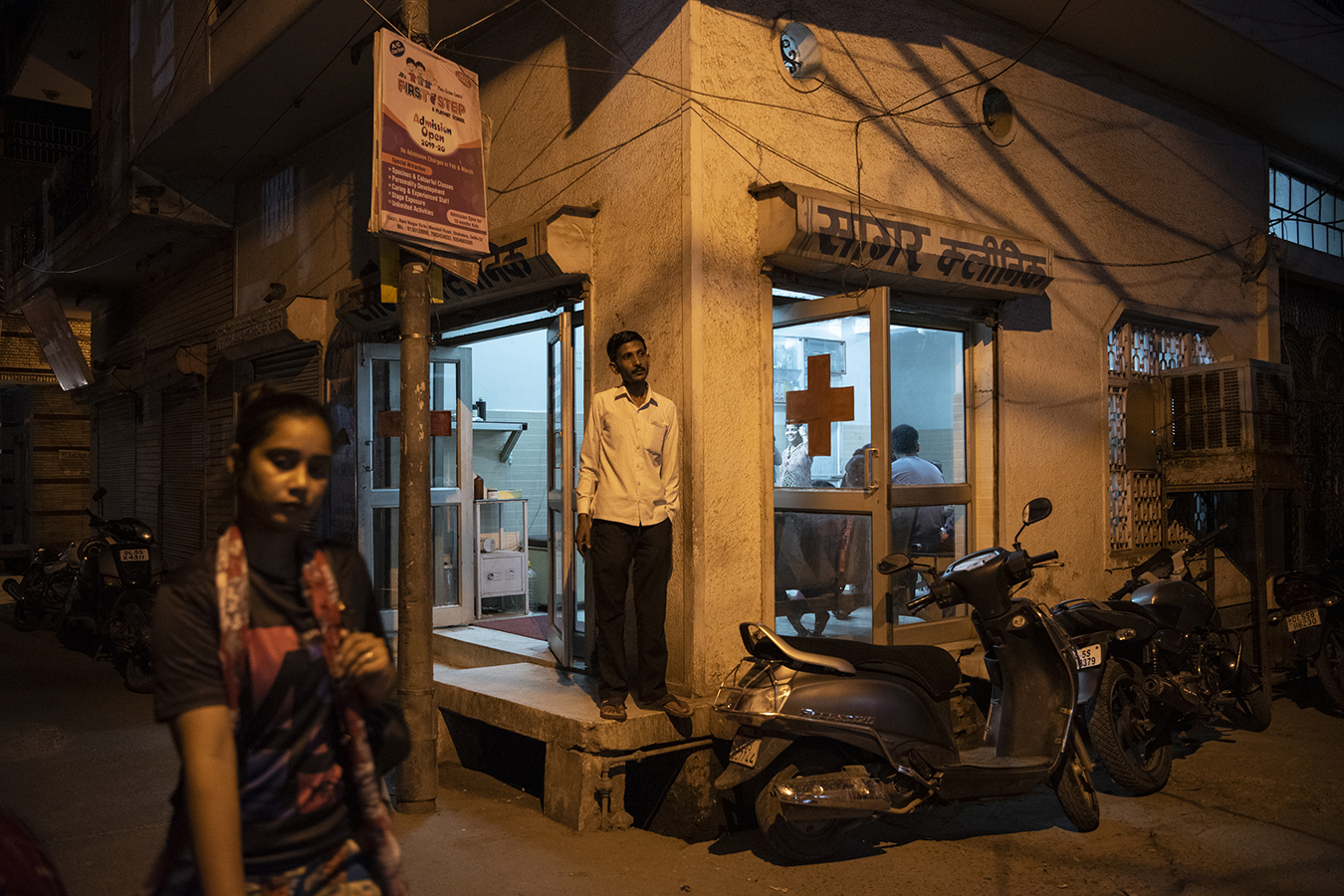
A man stands outside Dr. Sunil Sagar’s clinic, which caters to residents of Bhagwanpur Khera. (Saumya Khandelwal/The Guardian)
This story is the second in a two-part series. Read part one here: “In India’s Slums, Painkillers Part Of Daily Routine.”
NEW DELHI — In the crowded waiting room of Dr. Sunil Sagar’s clinic, in the working-class neighborhood of Bhagwanpur Khera, a toddler breathes from a nebulizer. Fever is widespread, and the air quality in Delhi has reached “severe-plus emergency.” The patients sit, motionless, but there is somehow tremendous noise. The clinic is a squat cement building draped in wires, a red cross on the door. Sagar sits behind a desk in a small, open room, as a squad of assistants escort patients to him. He seems utterly unflappable.
A father with a troubled look sits down next to the doctor, holding a baby. Sagar listens to the baby’s chest with a stethoscope, pulls out scrap paper and writes a prescription. The father hands over a few rupees, and Sagar places the bills into a money drawer under his desk. The entire exchange takes perhaps two minutes.
Medicine in India is transactional. A well-liked doctor hands over a prescription at the end of every visit. Why else have I paid cash to see the doctor, if not for relief? The precariousness of daily life leaves little room for downtime.
As the Indian government reluctantly loosens its prescription opioid laws after decades of lobbying by palliative care advocates desperate to ease their patients’ acute pain, the nation’s sprawling, cash-fed health care system is ripe for misuse. The sheer size of India’s system — tens of millions of doctors and pharmacies spread across the subcontinent — makes oversight difficult but presents a tantalizing opportunity for India’s burgeoning pain industry and multinational pharmaceutical companies seeking new markets.
A popular spot to purchase these bulk drugs is the Bhagirath Palace in the Chandni Chowk market, one of India’s largest wholesale markets that dates to the 17th century. It is a dense maze where men — and it is almost entirely men — press their bodies into a current of commercial ecstasy, frequently thrown off course by honking auto rickshaw drivers. One after the next, stalls of drug distributors advertise on brightly painted signs “all types of medicines,” “life-saving anti-cancer drugs,” “deal in Glaxo … Johnson & Johnson.” Inside the stalls, boxes of medicine are stacked from floor to ceiling.
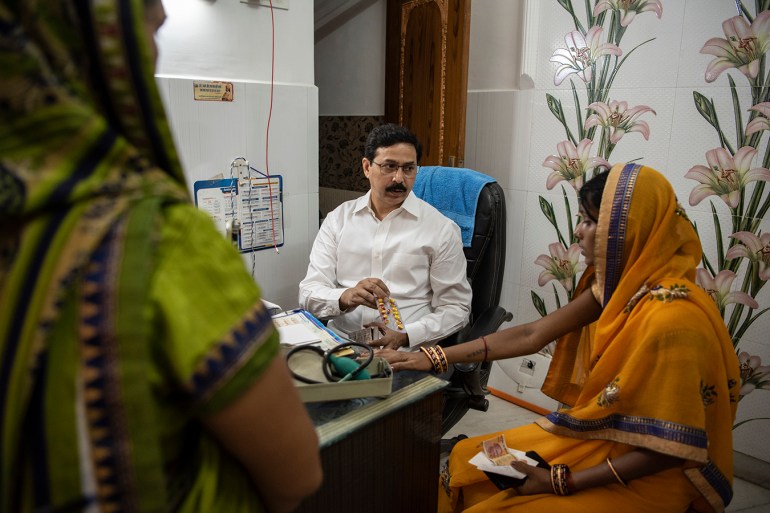
Dr. Sunil Sagar checks medicines after he examines a patient at his clinic.(Saumya Khandelwal/The Guardian)
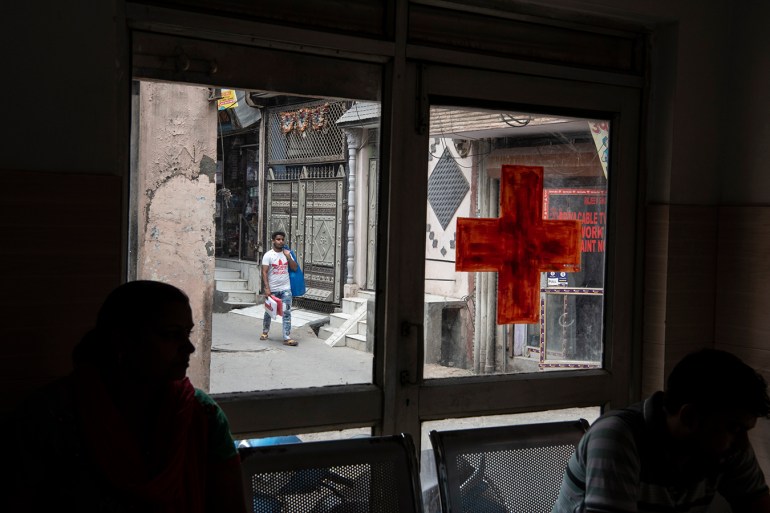
An outside view from Dr. Sunil Sagar’s clinic.(Saumya Khandelwal/The Guardian)
One drug wholesaler in the market said the government has been cracking down lately on certain medicines. Recently, he had received a list of 328 drugs that he was not supposed to stock, including Sulpitac, an antipsychotic medication used to treat schizophrenia. The wholesaler said people had been taking it like “dal and rice” for headaches.
Like its rigid caste system, India’s pain industry is stratified. The well-to-do visit well-appointed pain clinics, the working class turn to their neighborhood doctors, and the lower castes, especially those living in India’s vast slums, scramble for relief at roadside pharmacies, called chemists.
In the Mankhurd slum in Mumbai, where the average life expectancy is 39, toddlers wander bare-bottomed, defecating in the street. Children scratch at infections on their legs. Without any municipal water, hawkers sell plastic sandwich bags filled with dirty water for 2 rupees. In this place, pain remedies are readily available.
At Shiv Medical & General Stores, an older boy tending the stall wrote out a receipt for Ultracet, branded tramadol tablets — an opioid analgesic — made by a Johnson & Johnson subsidiary. “Doctor’s name?” he asked. Our guide, Mayur Helia, a community organizer, made one up. “Shagmu,” Helia said, giggling, and the shopkeeper wrote it down.
Helia and his colleagues are activists agitating for drinking water and sanitation in the Mumbai-area slums. “Painkillers are part of the daily routine,” said social worker Alfiya Mulla. “They have become more normalized.”
“You go to the chemist,” Helia added, “and you say, ‘I have this pain,’ and he will give you painkillers without any prescription.”
Daily life here is a pageant of hustle. For women in the slums, Mulla said, that means lugging 35-liter buckets of water. “You have to take that from half a kilometer away, and that’s why women have to take that” — she motioned to the box of Ultracet — “because they are hurting their backs.”
She turned the box over in her hands. “Women are more affected and are more addicted to this tablet.”
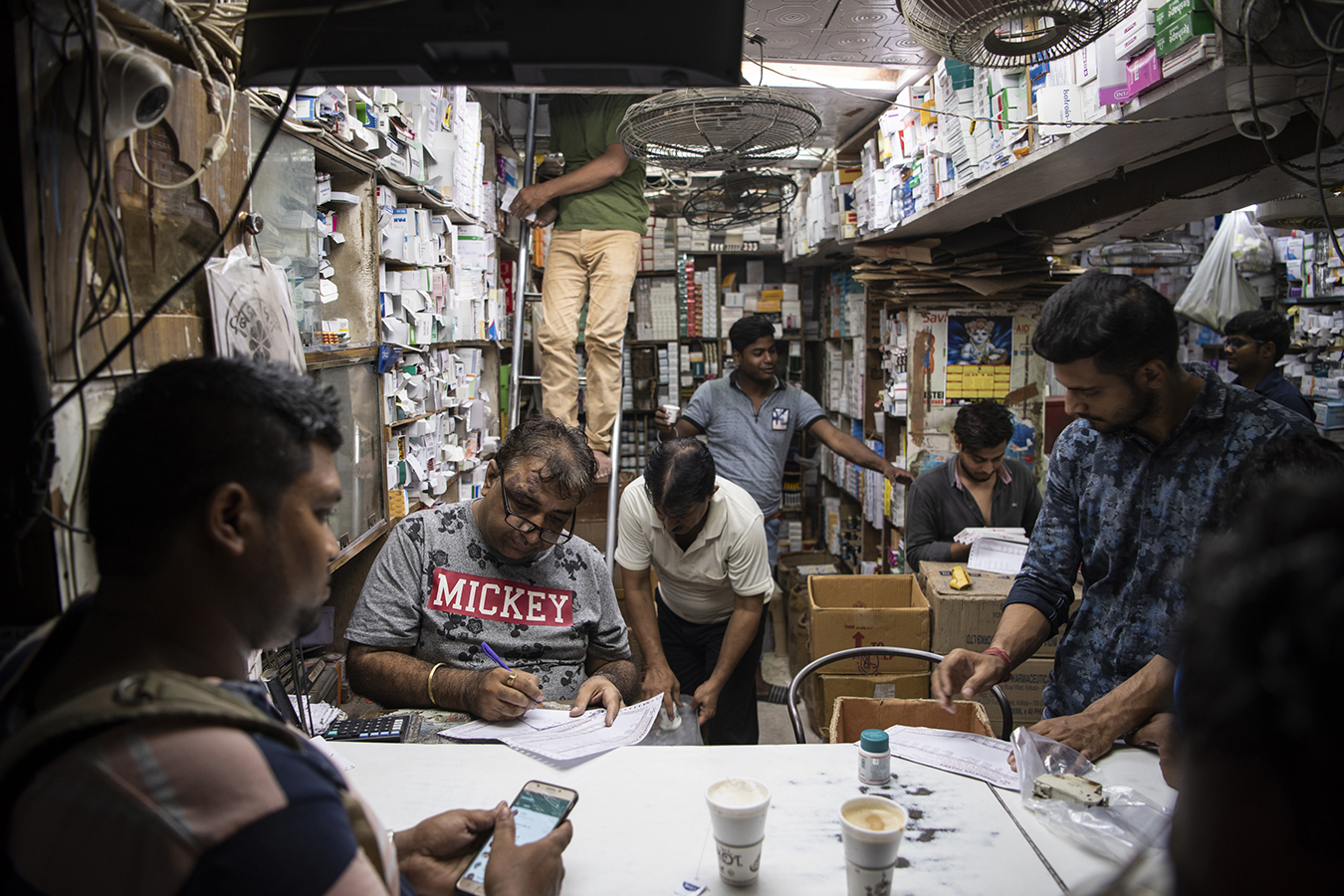
Shopkeepers work inside a pharmacy shop at the Bhagirath Palace pharmaceuticals market in Old Delhi. (Saumya Khandelwal/The Guardian)
Beautiful Laws, Lax Enforcement
As India flirts with liberalizing access to painkillers, government surveys show addiction to prescription opioids is on the rise. The northern state of Punjab, where heroin addiction is endemic, recently opened more than 160 outpatient opioid-assisted treatment clinics where addicts can receive substitute opioids like buprenorphine while they fight withdrawal.
But buprenorphine is also widely prescribed to treat chronic pain and has become a problem in its own right. Dr. Debasish Basu, a psychiatrist and professor at the Postgraduate Institute of Medical Education and Research in Chandigarh, one of India’s top medical institutes, said “the main prescription medicine that we’re seeing [people becoming addicted to] is buprenorphine.”
“The source for buprenorphine is a licit source; they are made in drug-manufacturing factories,” he said, but then “the diversion takes place.”
Basu echoed health experts across the country in saying the central government tightly regulates the production of narcotic painkillers, but there is little faith in its ability to control distribution. “The legal system is so lax, the monitoring system is so lax,” Basu lamented. “The laws are all there. Oh, there are beautiful laws. But the implementation is so lax that once something comes over here, it’s very difficult. It’s like a bonfire.”
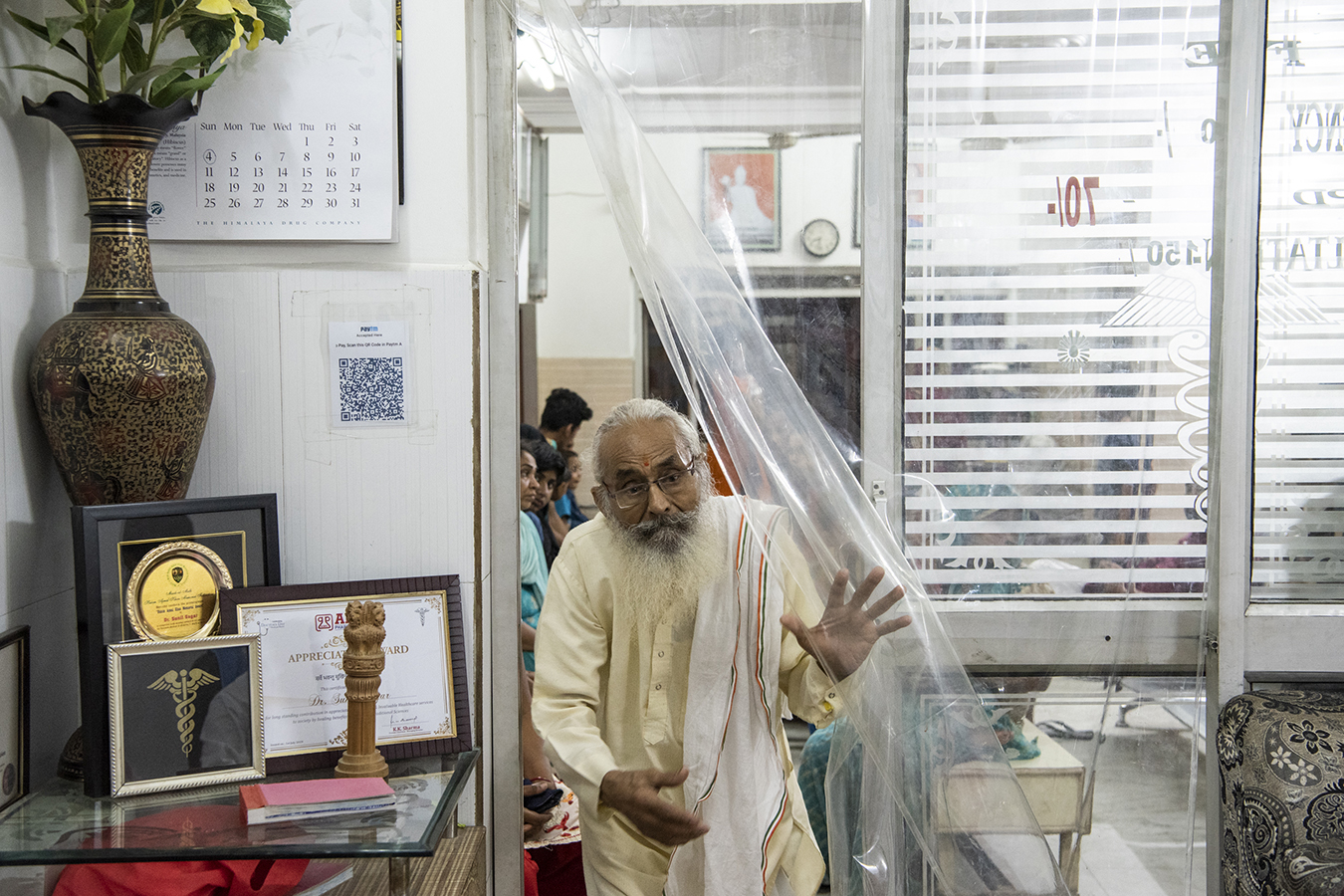
A patient enters Dr. Sunil Sagar’s office at his clinic. (Saumya Khandelwal/The Guardian)
If there is a precursor to an American-style opioid epidemic in India, it is tramadol, a painkiller that became available here in the early 1990s. Drugmakers — often citing studies they had funded — touted tramadol as less addictive than other painkillers.
“Tramadol information would come to every single clinician,” said Dr. Bobby John, a Delhi-based health expert. “Why? Because there is some drug salesperson sitting outside your door saying, ‘Hey, there’s a new drug. It’s non-addictive.’ Standard playbook.”
Tramadol flourished in India. Unlike morphine, fentanyl and other painkillers, the government initially placed few restrictions on its sale. But in 2018, after reports of abuse in the state of Punjab and reports of illicit Indian tramadol being sold to Boko Haram militants in Nigeria and elsewhere in Africa, Indian regulators enacted stricter controls.
If you cannot see the direct influence of American pharmaceutical companies in India, you can detect their shadow. In October 2018, just months after the Indian government clamped down on tramadol, a group of pain specialists from seven Southeast Asian countries, including three from influential hospitals in India, published a paper in the Journal of Pain Research.
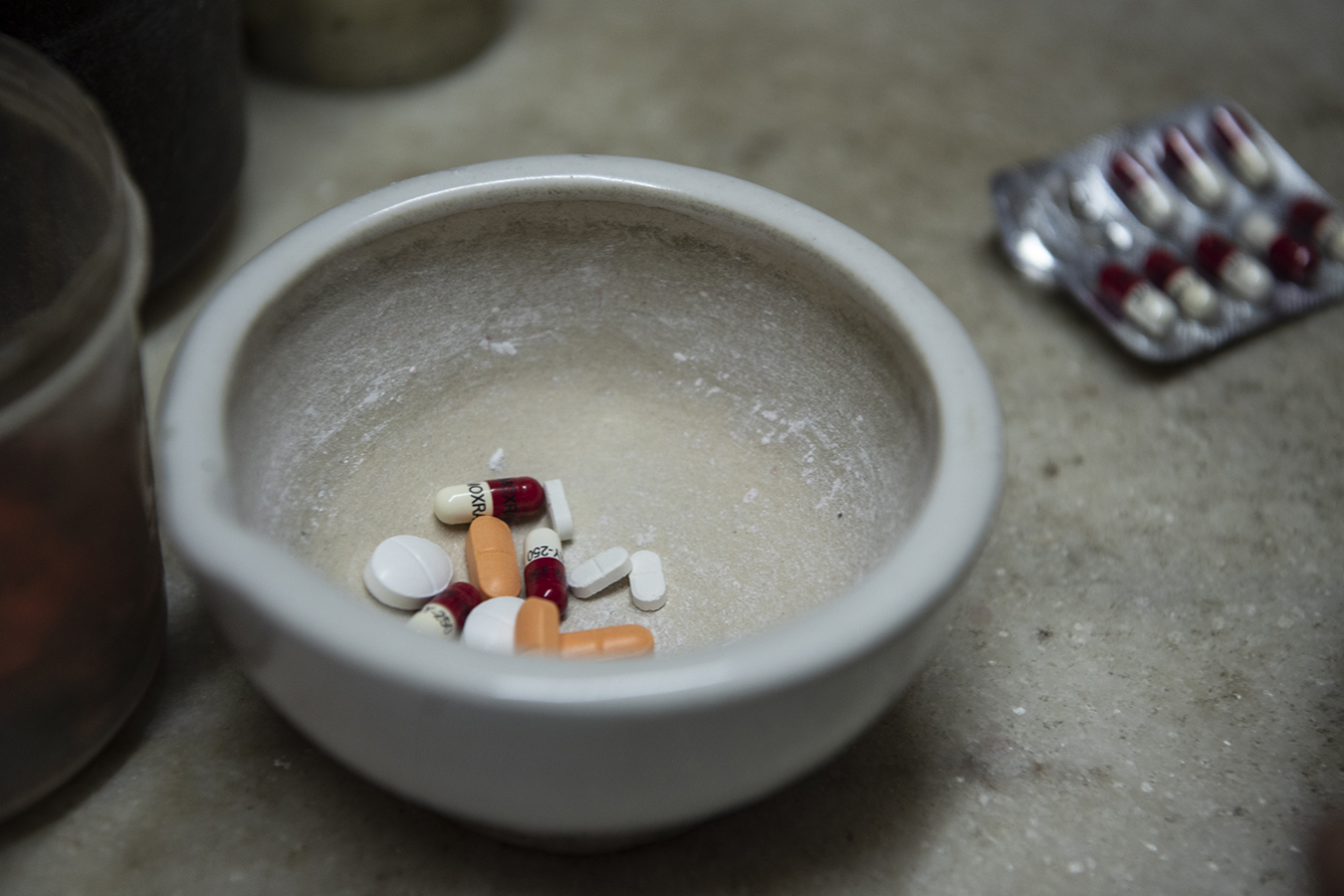
Loose pills at Dr. Sagar’s clinic dispensary. (Saumya Khandelwal/The Guardian)
“Tramadol: A Valuable Treatment for Pain in Southeast Asian Countries” made the case that “the weak opioid tramadol has become the analgesic most frequently used in the region to treat moderate to severe pain.” The paper concluded: “If it were to become a controlled substance, the standard of pain management in the region would decline.”
The paper was funded by Grünenthal GmbH of Germany, a company that signed a deal in May 2018 to allow Mundipharma to market and distribute its tramadol product, Tramal, in China. Authors included pain specialists who have received consulting and lecturing fees from Pfizer, Johnson & Johnson and Mundipharma, a network of companies controlled by the Sackler family, owners of Connecticut-based Purdue Pharma.
Dr. Pooja Garg runs an opioid-assisted addiction recovery clinic on the outskirts of Chandigarh, one of five in the area. Addicts in the area favor heroin, she said, but when they cannot find or afford heroin, “they take whatever they can get over the counter from chemists.” That tends to be tramadol, which, despite the new restrictions, remains widely available.
The bustling waiting room led into a peaceful inner courtyard where, on a weekday morning last November, dozens of young men, in their late teens and 20s, had come for inpatient treatment. In one bedroom, several men sat cross-legged on a pair of metal cots. The young men said they took tramadol or buprenorphine, whatever they could get. “It depends on the availability at that particular moment,” one said. They all agreed tramadol was easy to buy from local chemists.
India sits between the two largest illicit opium-growing regions, the Golden Crescent of Afghanistan, Iran and Pakistan, and the Golden Triangle of Laos, Myanmar and Thailand; and India itself is one of the largest producers of legal opium. Much of the heroin passes through Punjab, a state of 28 million in northwestern India that has struggled with opioid addiction.
That history of heroin addiction makes those in Punjab and other nearby states especially vulnerable to synthetic opioids, said Dr. Anshu Garg, an addiction counselor in Mohali. Heroin “is freely available in the villages,” he said. “People try it without knowing the consequences. They try it once or twice, they get addicted to it.”

A pharmacy shop in Bhagwanpur Khera, New Delhi. (Saumya Khandelwal/The Guardian)
Sharing The Spoils
Vijay Bhatia can attest to how the business acumen propelling India toward economic prosperity has been brazenly co-opted by eager pharmaceutical companies.
Bhatia worked in pharmaceutical sales for two decades for a handful of companies, including GlaxoSmithKline and Ranbaxy Laboratories, an Indian generics maker owned by Sun Pharma. He now works in Chandigarh, where he oversees sales for Atulaya Healthcare, a chain of diagnostic imaging centers. Bhatia was among several current or former pharma representatives interviewed who described how multinational drugmakers deploy sophisticated methods in India for getting their products prescribed.
Drugmakers routinely give sales representatives extra money to offer doctors cash or gifts — iPads, cars, trips to conferences — to prescribe the drug they’re selling, Bhatia said. He described how sales reps give influential doctors free products to test with patients and how some doctors, in turn, deliver lectures at all-expenses-paid symposia, often presenting research papers sponsored by the drug companies.
The multinational companies “have access to all these top opinion leaders,” Bhatia said. They will sponsor doctors to live “abroad for studies being done there. It is circumventing the entire marketing process. It’s another way of taking the doctor into the loop.”
“Suppose a product costs $100. To the company, it is costing $20. Now they have $80 to play with,” Bhatia explained. “So they’ll keep a safe margin, say, ‘OK, fine, this much money you can keep for ongoing practices or for sponsoring the doctor or, right or wrong, bribing the doctor.’”
Engendering loyalty with chemists is a top priority. To make his sales targets, Bhatia said, he would offer financial incentives to chemists who would “substitute [a product] with my product. In India, the chemist becomes king.”
Multinational pharmaceutical companies maintain they are ethical purveyors of their products. “Opioid pain medications play an essential role in the management of severe pain and it’s important they be recognized by health authorities as important therapeutic options, especially in cancer pain,” Manmohan Singh, a vice president at Modi-Mundipharma in New Delhi, said in a written statement. But, he said, “they need to be appropriately prescribed, monitored and reviewed to minimize the risks of misuse and abuse.”
In all sales promotions, Singh said, his company stresses that patients should be carefully selected, prescribed the lowest effective dosage, and made aware of both the treatment goals and potential side effects. “The exact prevalence of addiction with opioids is difficult to determine,” he said. “Signs of addictive behavior should be monitored and addressed.”

A woman looks out from a balcony of a house near Sagar’s clinic, which caters to residents of Bhagwanpur Khera. (Saumya Khandelwal/The Guardian)
In Thiruvananthapuram, in the southern state of Kerala, Dr. M.R. Rajagopal knows all too well that a powerful drug company, a greedy pharmaceutical salesman, an unscrupulous pain doctor, a reckless morphine addict or any whiff of scandal somewhere on the subcontinent could sink his life’s work. Widely viewed as the father of palliative care here, he is frankly tired of “opiophobia,” the “prejudice and misinformation” that the medical use of opioids will lead to addiction and crime. He is tired of reassuring Indian bureaucrats they are not ushering in a U.S.-style opioid epidemic. He has no time for doomsday scenarios; there are too many Indians in agony.
“This is a rather horrible country to die in,” Rajagopal told a roomful of doctors and medical students last fall at Sree Gokulam Medical College, on the outskirts of Thiruvananthapuram. He stood unassumingly at the front of a hospital conference room darkened by thick red drapes. Even with a microphone, his voice was gentle. “If a patient cries in pain for two weeks” at the end of his life, Rajagopal said, “it is hard to remember any good times.” When they are dying, he urged the crowd, “Give morphine.”
Despite the blossoming pain industry, Rajagopal estimates no more than 2% of Indians have access to palliative care. In his testimony for a three-year study of untreated pain published by the Lancet medical journal in 2018, he recounted the story of “Mr. S,” who came to a palliative care clinic in Calicut, Kerala, with crippling pain from lung cancer. He put the man on morphine, and a few hours later, Mr. S “surveyed himself with disbelief. He had neither hoped nor conceived of the possibility that this kind of relief was possible.”
When Mr. S returned the following month, the clinic had run out of morphine. The patient “told us with outward calm, ‘I shall come again next Wednesday. I will bring a piece of rope with me. If the tablets are still not here, I am going to hang myself from that tree.’
“He pointed to the window. I believed he meant what he said.”
Read part one of this two-part series: “Beset By Lawsuits And Criticism In U.S., Opioid Makers Eye New Market In India”
This story was produced by Kaiser Health News, an editorially independent program of the Kaiser Family Foundation.

